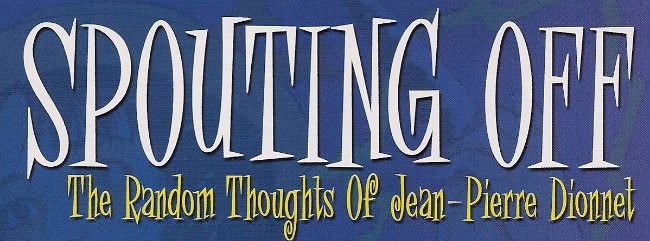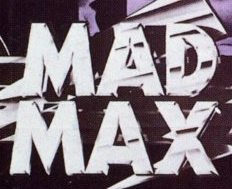It was a decade ago when I first encountered the writing of Jean-Pierre Dionnet. I was reading Métal Hurlant -- which is to say, the latter-day revival of that vaunted comics forum which Humanoids, Inc., the North American offshoot of Les Humanoïdes Associés, translated across 14 issues from 2002 to 2004 -- and I became transfixed by a detailed, digressive column, "Spouting Off", written by this man, Dionnet, of whom I'd never heard. "You can fill an entire column with unvarnished enthusiasm about books you've just read?" I wondered, agog, gears slowly clicking together in my head.
In time, I would learn much more about this traveled fellow, born in 1947: how he'd written about comics since the 1960s; how he'd been present for the upheavals at the famous magazine Pilote, which shook under the maturing of French comics; how, with the artists Jean "Moebius" Giraud & Philippe Druillet, and the financier Bernard Farkas, he had helped found Les Humanoïdes itself and begun editing Métal Hurlant in 1974; how he'd witnessed the birth of Heavy Metal, a prodigal American offspring, later in '77; how he then became a television personality, and a film distributor, and a man-about-town.
And how, most enigmatically of all, he wrote a few comics.
I say "few" because Dionnet's comics have never been well-represented in English. For ten years, I could find only two of his books, both collecting works originating in the 1970s: (1) Humanoids' 2002 release of Exterminator 17, a theologically-inclined fable of an android soldier becoming fused with its creator, drawn by Enki Bilal; and (2) Conquering Armies, a compendium of mysterious and quixotic war stories drawn by the late, great Jean-Claude Gal. The latter was among the first books Heavy Metal released in compiled form, all the way back in '78; it became a fascination of mine, moving me to devote one of my own capricious columns of odds 'n sods to its epic dimensions.
You could imagine my interest, then, when Humanoids announced a new 2013 edition of that very work: Armies, now coupling the original Conquering Armies, in color, with the entirety of a subsequent Gal/Dionnet series, Arn, recounting the amoral history of a fantasy world's martial son with aid from the scriptwriter "Picaret." I was offered a chance to speak with Dionnet about this release, and I readily agreed, despite wondering how I could possibly think of good questions to ask when the man himself had written a very thorough and interesting account of the stories' creation as a preface to the new book.
I needn't have worried. Like the columnist I'd known when we both were younger, Dionnet required little prompting to divulge his impressions. We spoke by phone, in English, and then a transcript was prepared by Keith Barbalato, Lucy Kiester and Sonya Selbach at Fantagraphics, which I edited, and Dionnet corrected & amended via email. I have elected to retain as much of the cadence of Dionnet's speech as possible, because this is very much a declaration by him: a testimony, submitted to a culture he has admired both skeptically and wholeheartedly, and which will hopefully not suffer too many more years' passage before he connects to it next in comics.
--
Is it true that you had written essays about comics before you started writing them?
Yes. I started when I was quite young, around 16, 17. Not exactly 16; when I was 16 I was still reading comics. I’ve read comics all my life. Mostly just cheap ones. So, I read a lot of DC and Marvel comics before we knew what it was, because it was repackaged in black and white. Because for the price of a Spirou magazine, you could have ten fat books of black-and-white comics. So my choice was doubled.
And, my father won a contest. So, when I was very young I won the first year of a new magazine. It was from number 1 to number 52. It was a gas station - you could win the biggest new magazine coming, it was called Pilote.
So, that was a good side. The bad side is that, anyway – so, all the kids were taking Tintin, or they were taking Spirou, or they were taking other magazines, but me, I was only into the small-format magazines, very cheap. So I was disconnected from the other kids.
And I also preferred the bad kids of the block – they fascinated me. I pushed them, they pushed me – I did some burglary, loved the feeling, learned the tricks. Much later, when I met my actual wife, she worked in a big house with a lot of security. She was out, and I saw the “lost angles” of the cameras [i.e. areas not in camera range], so I jumped, counted to three, walked, stayed in a dead angle – and when she came I was there to greet her. I was lucky. The cops knew and they came to see my parents, but my father never touched me. It was the second time, and I stopped.
And I found that, at the market, you could buy for very cheap all the comics released from 1945, something like that, in big fat books including [Le Journal de] Mickey, with "Prince Valiant"; including some Communist magazines, very good - Vaillant, where they started [Nikita] Mandryka and Raymond Poïvet. So I was fanatical about comics.

I was in a very strict Catholic school. So I would not read comics during the week, because we had one half an hour to read at night, and I was picking real books for that time, and that was mostly romantic writers. And of course, since I was a teenager, the ones that looked weird, like – [Joris-Karl] Huysmans, who was doing things about demonology, like, of course, Baudelaire, like Edgar Allan Poe, and I discovered the first edition of Lovecraft and people like that. But on the weekend, I would read the comics, because comics are faster to read.
We had a big house and the last floor was mine, so I started to read tons of things.
The first article - when I came to Paris I went to three universities. One to learn journalism, that I finished. One to learn, later, some theology, “Humanities.” I did two years, but the professors often were not very good, very permissive (it was 1968), save for one that was later a collaborator at Métal Hurlant; he was using one of my articles as a basis for a popular literature option, and we became instant friends. Jacques Goimard; he was head of the Sorbonne at the time, and head of the literary supplement of Le Monde.
And also, I was doing law school. I didn’t like it because I had a very puritan view of the world at the time. I didn't want to learn how to shield with the law. I don’t like - I think that there was right or wrong. I’m not [Steve] Ditko, but I think there was right or wrong, and we were learning the tricks, when you are guilty, to escape. I don't like that.
Yes, yes, yes.
So since my parents were giving me some money for school, and I was only going to university on the first days, and then one month before the exams, learning very fast to go to the next year – I had already considered myself as a freak, wanting both to be different and to be accepted. I wanted “le beurre et l'argent du beurre” ['to have the butter and sell it as well'] as we say. This is my life.
I started with a guy with a very small stand in “The Flea Market” where he was selling old records and old phonographs, and he had a small bunch of comics. And I shared the stand, and later on we moved to a very small shop called Futuropolis. It was full of windows, very bad for the books. But then we moved to a bigger one, and then we started a fanzine called Futuropolis. And also in that shop I met some publishers. And I was young, but very tenacious. People were doing the French version of Galaxy [Science Fiction], people were doing multiple science fiction books. There was a magazine called Universe – they asked me for articles.

So, my first articles were mostly about people we knew nothing about in France, like [Frank] Frazetta. And I had to do my own research, I worked with gaps; I learned much much later that if there was a gap in my listing, it was because it was the years he was working for Al Capp. And I did things about some weird Italo-French comics from Italy which were totally unknown. And then came the exposition in 1968 at Arts Décoratifs and the Louvre [L'exposition Bande dessinée et Figuration narrative], and they [i.e. Société Civile d’Etude et de Recherche des Littératures Dessinées, or SOCERLID, which organized the exhibition] put out a magazine called Phénix.
And in that magazine, I made a lot of articles because we made a trip to U.S.A. in 1969, I think, where I met everybody. I mean, from Milton Caniff to Stan Lee, to Lee Falk – a lot of interviews are still in my cellar, unpublished. I never found the time. Some of them, we became close friends. Not a lot. Because he was my mentor for business, with Will Eisner. I had a very close relationship with [Joe] Kubert, and it’s a shame, because four years ago he came to my place with Moebius, and now they are both gone. I had a very close relationship with Harvey Kurtzman, and a good relationship with Jim Steranko, and also, on the other side, I started to have a good relationship with Ron Turner and Art Spiegelman.
Oh, all right.
So I was in between, because since I was seeing it from France, to me there was no difference between underground and overground. When I saw the first things of – of course, [Victor] Moscosco, whatever, but the most affecting to me was [S.] Clay Wilson. Because it was something really, really weird, like music by Debussy to me, and I loved that work because I was so fascinated by high art and fascinated by movies. Seeing as many movies as I could see each day. And it was the same people at the time, who were talking in real magazines, or newspapers like Le Monde - comics, science fiction were suddenly recognized. I am talking now about a dead world: when France could discover Japanese art, “art nègre,” jazz, etc. We were then the center of the world. Now we are almost dead.
I began to have a very good relationship with the big publishers because of [Carmine] Infantino and Stan Lee. I was passing by all the time at DC and Marvel, and they were saying, “Do you want to take some page of Spider-Man or Kirby?” And I would say, “I pass on later, because now I have to do some shopping,” and I never took it.
Those were the days.
Yes, yes.
And so my first articles were mostly about comic books, because in France there never had been an article about comic books. I was particularly fascinated by the hand of Infantino, when he did Space Museum with no inkers and with very economic drawing. And he stopped, thinking he would never top Kubert, and [Alex] Toth, and I think he was the best of the bunch. But he just got way too late. He made a school of design, at 60-something, he was doing something unique, writing and drawing at the time, writing and drawing, with no inker. But he had to be king of the world at DC, he felt, and he never climbed back. That's weird: he was bigger than life, like Druillet, huge – and could not come back.
Philippe said to me the other day, “You look so small, and you come back. How many times, would you say?” I said, “If you include booze, new bosses who fire me, drugs, dying women – let's say five times.” And I realized, I was lucky. More lucky than strong. Something in the air said to me each time, “Time to get out of the hole, there is no more bombing, the sky is clear.” Right now I am amending my last combat, I hope, with internal revenue services. I've lost a lot, but I am alive, and I now know the end is near: I must still be generous with my time and money, to use as best I can in the time left. That's the only way – to stay the same and change at the same time.
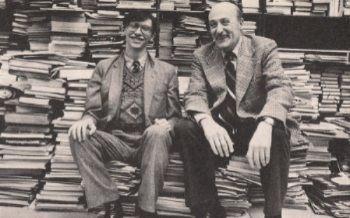
And I had some good times, when I was passing by with Kurtzman, who said, “I would love to be in San Francisco but I need money for my family to eat,” and was giving me all-new ECs, rare – absolutely new, like I gave later on: all-new Métals, 30 years later. The story goes on, and now I get it: I can fly, but not very high. I am responsible for my family.
They were all Jewish and Italian, those first masters [of comic books]. I was paying a visit to Brooklyn and the Bronx and the garment district in New York. Stan Lee was the other side, on New Jersey and whatever. Will and Kubert were showing me buildings where they lived. And it was a great time because I think that I was only guy interested in comic books, with Alain Resnais. We were quite close; what fun Alain had working on scripts with Stan Lee, who was writing a story for him, trying to do a Lovecraft movie. He could not do it; he was the guy who made Last Year at Marienbad, and conferences at universities paid his bills.
At the time we were often together, going to see Stan. Me, I was going into the shops, and at the time you could buy anything for nothing. I mean, you could buy all the L.B. Cole comics for nothing. You could buy everything for nothing. And I was receiving, each month, a huge package of DCs and Marvels, under my door. But my illumination was really coming from a shop where I was buying classic DC stuff I knew.
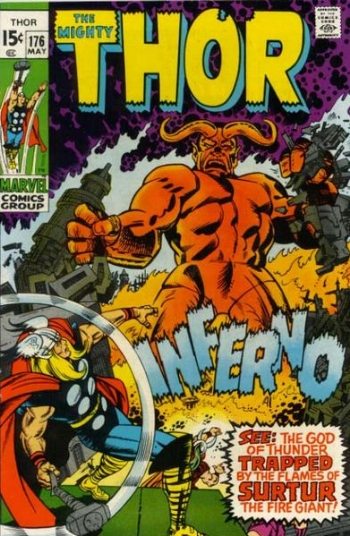 And then I found an Iron Man begun by Gene Colon and finished by Jack Kirby. And I found the Thor story where he goes in the Inferno. I was hooked, because suddenly I realized that he [Kirby] was the master of that new form called comics. Not coming from a good copy of comic strips like some others, because of a bunch of EC reprints or whatever. It wasn't something reminiscent of Alex Raymond. Al Williamson was very friendly. But with Kirby, I discovered a guy who, for me, opened the door and closed it. After, everything is postmodern, including Watchmen, which for me is the tomb of comics, built on the body of Ditko.
And then I found an Iron Man begun by Gene Colon and finished by Jack Kirby. And I found the Thor story where he goes in the Inferno. I was hooked, because suddenly I realized that he [Kirby] was the master of that new form called comics. Not coming from a good copy of comic strips like some others, because of a bunch of EC reprints or whatever. It wasn't something reminiscent of Alex Raymond. Al Williamson was very friendly. But with Kirby, I discovered a guy who, for me, opened the door and closed it. After, everything is postmodern, including Watchmen, which for me is the tomb of comics, built on the body of Ditko.
And I was visiting Neal Adams in his corner. I was going to movies – I remember one day I saw Taxi Driver, and they took me to meet Scorsese, to work on projects that never flied. Outside the theater it was looking exactly like in the movie: the old Broadway. After, I had a meeting with Jim Steranko in a seedy bar – the attitude, the look, he could have been in the Scorsese movie, he looked like Mickey Rourke in The Outsiders.
Yes, yes.
And those were the great Broadway times, and I was going to all the possible sex shops to buy photos of Bettie Page. And to have autographed photos of the girl who played Sheena, Irish McCalla. And I was very proud because I met her, she was so beautiful, even if she was aged.
I went to the first convention of [Phil] Seuling, where there was not a lot of people. And that’s where, because ... I was fascinated, and at the same time I was repulsed. Because I was born just after the war, and everything in France we released - there was a big, big, big invasion of American stuff. So it was a sort of colonization. And that I don’t like a lot.
So at first I was doing the small articles, and then I began to make more articles, and I learned to write. The first ones were very, very badly written, because I wanted to put too much info, and it was looking like the first Who's Who [of American Comic Books]. You know, a very boring listing. And I learned from that, that it was not important to give the whole listing, but to extend the why and the how and when it was done and why it was done. I'd already found a very good scholar who was doing things on atypical artists to compare comics and the other arts, Pierre Couperie, and I took it from there.
Mmm.
For example, I shall show in my next book, The Dream Machine, a book about high art and low, some paintings of [John] La Gatta that I had in posters. And I'll say, “You see, that was swiped by Alex Raymond.” But I said it's not so bad, because Alex Raymond drew very well at the time. Maybe he wanted to enter the administration of illustration to redo La Gatta as a sort of homage. I was comparing at the time the Pre-Raphaelites and the Studio – I was seeing a lot of [Michael Wm.] Kaluta, Jeff Jones, Bernie Wrightson, not Barry Smith. On the other side, I was meeting with wrench people into weird art who were selling drawings for nothing by Crumb. I met lot of the underground people at the same time.
And, also, I began to buy Sunday pages - and I discovered, mostly, that the golden age was very early. With Hearst, until let's say Caniff. And I was buying, at the time, the records with Jack Davis sleeves, and later, one by [Bernard] Krigstein, from Jim Vadeboncoeur, with the original art of a first version, which was much better but refused.
So I was really an American fan, because the movies made me a fan of Western films. And, through Westerns, I lived in the American dream. I lived a different version of the American dream later. It took me time to discern that the dream had been built by people like Capra or Ford: just a dream.
So, eventually you started writing comics, I believe, in Pilote. Was that Druillet who got you into that?
Yes! Yes, I worked in that small shop, Futuropolis. It was very small, but everybody who was interested in fantasy and science-fiction passed by and we would all meet on Saturday night at Druillet's place -- writers, artists, new artists like [Jacques] Tardi -- everybody was there, each Saturday night. I'd go to one or two and Philippe would say, “OK, but what are you doing? Why don't you write comics?” I said, “But I don’t know how you write comics.” He’d say, “But you know, you know.” So I came to Pilote to do what they called actualités.
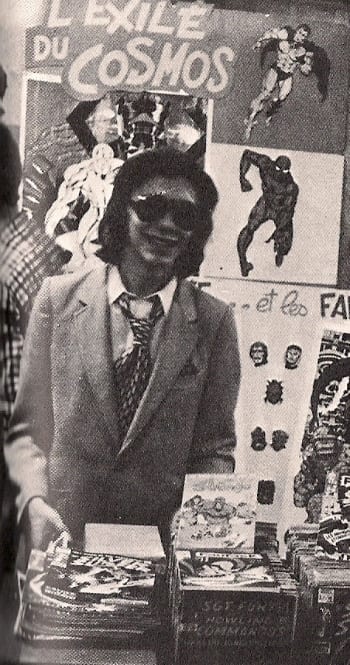
Yeah.
It was sort of Mad things, because that is our bad judgment. [René] Goscinny [the editor-in-chief] was difficult to work with, because the year before, in 1968, there was a sort of prosecuting of him; he was cornered by the artists, particularly Gir [i.e. Moebius]. The artists said he was not their boss, their boss was liberty, blah bah blah, and Goscinny, who had paid for everything with Asterix, became very sour. I remember he was very tied up, used a blank face, so I knew him too late.
But he was aware that because I started doing those actualités - mostly with Druillet, Moebius, we were doing pages about science fiction without really having a story, and we had to leave a lot of it out. By the end of next year, there will be a book of all those pages of Pilote, some very psychedelic, and it shall have 255 pages of unpublished material and an autobiography of the times. I called it “LIES”, because I don't care about what really happened and the dates, just the feelings, even if I don't remember well.
And these actualities, those are like non-fiction comics?
Yes, because it was mostly jokes. Movie parodies. I was very bad at that. I made one or two where I believed the movie was good but I was lying in the parody. I did one about Soleil rouge, a European co-production by Terence Young with Alain Delon and Toshiro Mifune, but I didn’t know later I would meet Toshiro Mifune and Delon on a movie project that I could not raise money for. I'm not good at that, I'm more comfortable with the small money and individuality of comics.
I was doing funny gags, one about Serge Gainsbourg, and later on we became friends. And I could put out some articles - the first big article about Bruce Lee. I didn't know later on I'd meet with his daughter and his son. I was comparing him to [Vaslav] Nijinsky and Fred Astaire and not taking the fighting side. Always trying to find a peculiar angle. I was also doing some psychedelic stuff with Jean Solé. That, they let me do. But as soon I was not doing something funny, they were very reluctant.
One day, in 1970, I met Jean-Claude Gal in a shop, and I could say one story was truly the start of Conquering Armies in Pilote. But when we brought it they said, “No, we don’t have room.” And I was a lucky guy, because Goscinny turned down our big story I wanted to do with Moebius because he wanted more Blueberry. He said, “It's good, but I don’t want that.” He said to me, “Maybe you can do a science fiction magazine with us because I don’t have enough room in Pilote.”
By luck, he forgot. Because I think he would not have let us do exactly what we wanted to do. And so, time passed, and [Nikita] Mandryka who'd worked a separation with L'Écho des Savanes [in 1972] with [Claire] Bretécher and [Marcel] Gotlib - Bretécher and Gotlib were mostly staying at home doing their drawings, so he called me a Number Two to help him find new people. So brought a lot of people like Francis Masse, Wally Wood. People who were being rejected from Pilote, like [René] Pétillon.
At the same time I started a magazine project called Snark for Nathan, and they said they would not publish it. It was a strange venture, because there were four editors-in-chief; one was Jean-Claude Forest, who was wonderful, but had very strong views of what was good and not good. A hydra that could not walk with four heads. Lucky again.
Me, I was more into everything, not judging the ideas so much as the style connected to it.
So I begin to talk with Mandryka on one side, and with Moebius and Druillet to do our own magazine. Mandryka found the title. I found the “Les Humanoïdes Associés” because I loved The Humanoids by Jack Williamson. And also because “Associés” - like, you know, it was very cheap, like a small society. "Associated" was a sort of joke, because it means a small company.
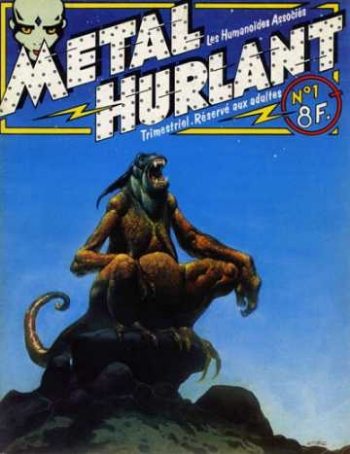
And one day Mandryka phoned me, you know, “We are not doing so well,” because we have two distributors who have fled with the money. So, we'd left Pilote to do it with L'Écho des Savanes - “you would be stupid to do it with us, do it yourself.” So I saw Moebius, I saw Druillet, and we decided to start on our own. And it was the same story all over again, because I never thought I could be a publisher. It was an idea that reminded me of Resnais, who said before, the same thing: I never think I could do anything, I was a reader. I was doing a small fanzine with thirty copies and sending ten to America to Paul Levitz; “international correspondent” who were sending me ten of his fanzine, and I was happy like that. And so, we started the magazine. But after two issues I discovered that Moebius and Druillet don’t have the time to take care of the magazine. We had to become a monthly [with issue #9] because in France we also had a distributor who fled with the money. So we had to take the national distribution company, but they said, “You are paid at the next issue,” so we had to become a monthly.
So suddenly, everybody in a new generation is connecting. I didn’t know that a new generation was waiting to do the next thing. They came from everywhere. As said the Nietzschean philosopher Bruce Willis, about his movie Die Hard, you only come at the right place, at the right moment, one time. An all-new generation, mostly in science fiction at the beginning, but after, some of them were singers, artists, whatever. Some came with dirty drawings, and I took them the same way I used some sex to sell; then we stopped showing sex, because we knew it was suddenly okay – we were kids. Some were waiting for the flying saucers to come to earth.
Me, I had no point of view. In my head, I was like Elric of [Michael] Moorcock, a servant of the chaos. Some were communists, but they were Stalinians. Some were near the right – I mean the extreme right, but not in what they brought me. It was funny. So my idea was that my taste was not important. What was important was that the stories were well done, that those people were convinced - I would publish them. The tone of the magazine would come from a mix of everything.
My ideology was “no ideology.” I mean that I could say what I wanted to say, but I don’t ask the people working with me to share my point of view. And since I was, in the beginning, a very shy guy, I'd go somewhere in the country to meet guys who were too scared to come from the suburbs to Paris - imagine for people living in the country. So I got people like [Yves] Chaland or Serge Clerc by writing them in their small cities in France. I had to meet up with the mother of Serge Clerc saying “OK, he shall not go through studies, but I guarantee you that he shall win enough money to be happy,” and things like that.
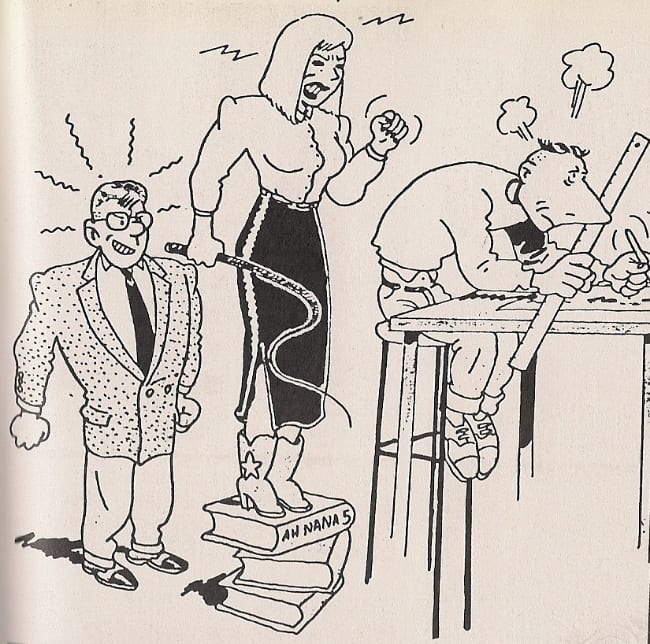
And in the beginning, we were saved by one book which sold. It’s the same old song for everybody. It was Gwendoline [a collection of work by erotic artist John Willie], brought to us by Jeff Rund. People were coming to buy one book by Moebius at the small office we had, one book by Druillet, one book by me, the stories I did in Pilote with Solé [Je m'appelle Jean Cyriaque], and saying “I want each one,” putting Gwendoline in the middle. Like in a sex shop, you know.
Yes, yes.
I started Conquering Armies, but I'll come to that later. First we had the Italian people of Linus who came to do a deal with us to publish everything. And I was very happy, because it was Fellini who put us in connection with the people of Linus. We had Spain very fast, and we had Germany quite fast with Schwermetall, where the financial adviser was a guy named Benedikt Taschen.
And then I did some very bad things, that, thirty years having passed, could be considered criminal. The first one was to intrude in the night at the offices of L'Écho, to steal with Druillet their subscriber listing in photocopies.
I also made a sort of scheme to be published in America.

I mean, I had seen Stan Lee, or sent him a letter, and he said, “Oh, maybe it cannot work here.” I had seen Infantino, and I sent him an issue; he was not enthusiastic. And Joe Kubert told me not to do it. I had seen Bob Guccione, and he scared me to death, because he was living in a very big house with Christs everywhere, and naked ladies. So he scared me a lot. And I met Len Mogel of National Lampoon.
Mmm-hmm.
My scheme was not as scary in the beginning. I really believed through the stories that I had seen, that maybe we could do an edition of the Lampoon. But very, very fast, I understood that it was not possible because it was very American, and there were only very few pages, like Gahan Wilson's Nuts, that I could use. And some parodies. But I noticed that each time Len Mogel came to Paris, or invited me to New York, his wife walked into the next room reading Métal Hurlant, trying to understand it. And each time I saw her become more enthusiastic. So I pushed, I pushed, I pushed - and one day Len said, “Oh, my daughter, my wife loves Métal Hurlant a lot; maybe we could do an exchange? You do Lampoon in France and we do Heavy Metal.” And I said yes, but I already knew that I would never do the Lampoon.
So, I'll remember this day all my life. I came on a plane, and I go to Times Square, not to the offices - and between Mad, Life, or whatever, but not in the comic section, I saw Heavy Metal. And I said, “I want it.”
I made a big mistake, because I said I don’t want to colonize America, so let’s say that it would be good if you can put some American stuff in also, maybe 10 or 20 percent. What I didn’t know is that all the editors – Julie Simmons was the daughter of [National Lampoon co-publisher] Matty Simmons, and Ted White – were great with science fiction, but had very bad taste in art, like a lot of science fiction people. They began to have stories by people I don't like. Aside from [Richard] Corben, who I published first. Aside from Kaluta. I was very naïve, I'd say maybe you could give stories to Spiegelman, to Crumb, to Moscoso. And they didn't want to work with those people. Art was starting RAW at the time, and didn't need to, but I think that most of them would have accepted to have, let’s say, a comics section in Metal at the time.
Yeah.
But then they - and they did something very strange. They made the stories funnier than they were. I think they knew that the stories were translated by the team who were still at the Lampoon at the time. So sometimes it was - even [John] Belushi passing by who would actually find a joke where there was no joke. But this, I don’t care, because with translation I think the music is more important than the thing, and they put music in it.
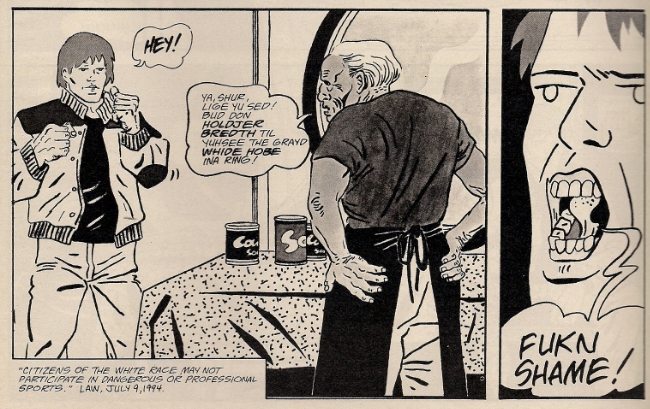
And we published three books; it was Conquering Armies and the Moebius book [Arzach], and the third one was Candice at Sea, by Jacques Lob & Georges Pichard, very “ooh la la.” And Conquering Armies, strangely, was the first one to sell, maybe because for an American it was looking like Frazetta or [Roy] Krenkel somewhere.
But we had a great, great opening at the Guggenheim, and I was king of the world. I remember John Cassavetes looking at the drawings of Moebius and, already drunk - there was the other guy, the guy who does Columbo, who said, “Whoa, I don’t understand that,” and there was a third one, the one I love the most, the one who played in a lot of movies with Cassavetes, Peter Falk, and the third one was, ah I forgot - he was in Saint Jack - Ben Gazzara!
All right, yeah.
And Ben Gazzara looks at the Moebius, and says, “Me, I think it’s beautiful.”
And after, I went to the Studio 54, and I was close with the nieces of [Paul] Morrissey, so I met Morrissey, Warhol. Warhol looked very fast, but he didn't really look, and Truman Capote was thinking I was “cute,” but didn't look either. Those were weird times.
Then I came back to France, though I would still have my habits at the Drake Hotel and drink champagne with Johnny Cool, Henry Silva; renting limos to be sure to pass the velvet rope in the new nightclub of the month. I was going back and forth between France and America, and since we started with no money at all, and always with success coming much later, I knew from the beginning that we were, let's say, one million dollars short. So, I put some nice papers together for some banks, and they believed me. I was young and I was confident that taking money from a bank, like you say, not reimbursed, if it's for the sake of art - it's good, you are Robin Hood.
And then we had to pay these banks, so we would go to another bank, and the hole was growing slowly, but regularly, because we had more to pay to the banks then we had profits. So I knew very early around the third and the fifth years of Métal [c. '78, '80] that we were doomed.
Yes.
But I never said it to the artists. Instead I became a night bird, because I could not sleep. And, after three or four years [in 1982], I started a TV show [Sex Machine, part of the television magazine Les Enfants du rock], re-released these days, thirty years later, which was exactly like Saturday Night Live, but in a French way, where I was playing, writing the sketch, or whatever; writing the stories. And then it was an immediate big success, with funk music, good actors (not me) and nude girls, where I was making a lot of money. Still puritan in my mind, I thought I didn't deserve it, and I spent it all.
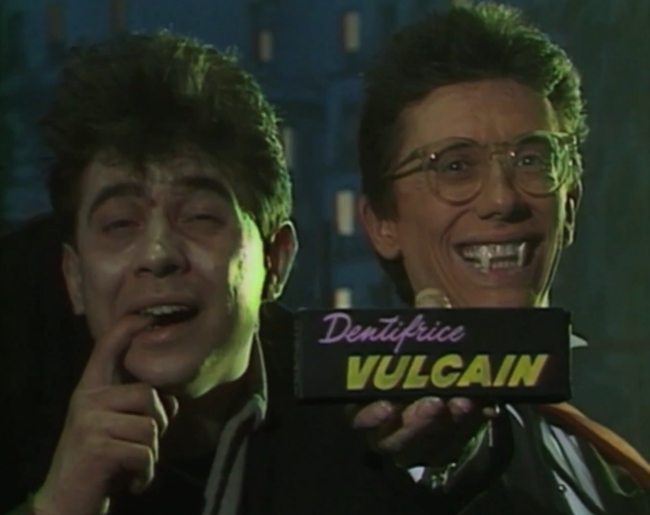
And I forgot the most important thing in the world: we published books, a lot, from Moebius to A Contract with God, but also “real” books: Philippe Garnier, who lived in LA, brought Bukowski, our biggest success until some fake revolutionaries working with Hachette's money stole him. He also brought Hunter Thompson, and I brought [Hubert] Selby and Eric Ambler, who was very difficult and snobbish (even Brian Aldiss told me he was) but very nice to me. if I had repeated what he explained to me about the undercurrent of history I could have been killed like Marathon Man at the time.
Strangely, we made more money there, but it was too late.
So, when my distributor was getting mad, beginning to push me a lot, when the Spanish people who were entering in the company were pushing me a lot [Les Humanoïdes Associés was partially acquired by a Spanish printing company in 1980], one day I said, “That’s enough.” And I asked all the artists to come to the office the day the real owner was there, and I brought them into a room and I said, “OK, you guys, you must know the truth now, we have been losing money for years, and I have to defend you each month in front of very stupid people who understand nothing. And so we shall make a revolution.”
And two-thirds of the artists said that’s not your problem. One-third of the artists said, “You should not have opened your mouth, you don’t understand that artists don’t think that way - in a collective way.” So I say, “OK.” I close the door, and I move to something else. But that’s my demon. That’s my demon, because when I was very successful in TV, I began to go to Asia [under the auspices of Canal+], and I started to be the first in nine years to distribute [Hayao] Miyazaki outside of Asia, and the first to distribute [Takeshi] Kitano outside of Asia. And for twenty years, I was in the movie business. At the same time [c. 1989] I started another TV show about all movies of the '60s [Cinéma de quartier], because I don’t like doing the same thing. I was doing comics from time to time but not on a regular basis.

I had come to the age of 55, and I did all the crazy things you can imagine. Doing everything you must not do. Incredible quantities of drugs, an incredible quantity of alcohol, and I had to be near death to stop. When they said I had six months to live - so I stopped. And I looked at myself in the mirror, like Travis Bickle, and there were some people that I saw on TV when I was a kid, who were my heroes, and had turned into old people who were still doing TV shows, with everybody joking about them, and I said, “Do you want to end like that?”
Yeah.
“What do you want to do?” And in between I had met some friends who said to me, “Why don’t you write again?” or whatever, so I say ok, I shall need less money from now on. But I shall do what I like, because I’m 60 – and now I’m 65 – and from now on, my time is on the countdown. Because I knew that I was not bad at writing comics, but it was not compatible with the night life, with the editor's life - I was editor later on again of L'Écho des Savanes, but I stopped after one year. I could not do it again, because they wanted me to bring successful people, and, me, I would bring a new generation without thinking.
So that, in short, is my life, with a lot of crazy stories because I was buying movies from Yakuza or Triads. But I did well. It did well, it did well. And, I stopped everything and I had a sort of - every ten years I get a bit of depression because I get older. So I met my fear of depression like usual. And I started working again. And yeah, I’m now finishing one book and starting another one.
Yes. Yeah, actually, I first came across your writing in the articles you did for the new Métal Hurlant after 2000, I think in 2003 or 2004, the essays you did for those. They had those in the American version that Humanoids put out.
Yes, yes - I remember that now, yes. You know, I have a very strange relationship with Humanoïdes, because they are the publisher of only my old stuff, I moved over with Casterman and Dargaud, but the fact that [Fabrice] Giger [who acquired the company in 1988, the year after Métal Hurlant ceased publication] maintains the thing's life means it's no more my baby. It was adopted by somebody else, who has very different views. But it’s not my problem. It’s not what I would do, but I think it’s what he thinks he must do, so let him do it, and in the meantime Humanoïdes is alive.
Yeah.
And for me, it’s very, very, very important that the company still goes on. I was very sad at what began when the Ninja Turtle guy [Kevin Eastman] bought it [Heavy Metal, in 1991], because it was really becoming something I don’t like at all. In terms of Humanoïdes, some stories are better than others, but some I like. So, well, that’s ok. But it’s - it's terrible you know - we were avant-garde, and I think you must not be avant-garde for too long. Because after, it becomes tricks. We had the usual span of life of an avant-garde thing.
There shall be a big exhibit, by Christmas, in France, done by a company of a shop called Leclerc. It shall be around Druillet, mostly, who sold a lot of original art to the owner of that huge, huge chain company, and Moebius and Bilal and Tardi, because history always chooses to pick up a few.
I made a big interview with Druillet for the exhibit, and he said the only fault we did – we made two faults. He said, one time, I was against you because you brought new guys on, and you were right. You made it into magazine; we were doing a fanzine in the beginning. And you were right about the new people, so the fault was mine [Druillet's].
He said the second fault that we made, is that there was no ideology, but a sort of organized chaos - why not an artistic movement? And instead of calling it Métal Hurlant, we'd better call it “Le Mouvement Métal Hurlant,” because it was like le mouvement surréaliste, or - and I think it’s true! I think it’s true. I learned it when Alain Resnais was my first subscriber, Chris Marker was the second one, Fellini the fifth. I learned it when a young George Lucas, I would ask for a foreword, and he would send me it the next week. I learned it, because when I met the writer of Scarface, Oliver Stone, people would say to him, “Oh, this guy is famous for his French TV show,” and he wouldn’t give a damn, and I would say to him, “I created Heavy Metal,” and he said, “Whoa man!”
Yeah.
The same thing with [Katsuhiro] Otomo, where they said “he is a TV guy” and after I said “I did Métal Hurlant” he said, “You did Exterminator 17?!” Suddenly excited, he said, “That’s where Akira comes from,” showing me a 17 on a tomb in the story. From a very small opening he saw the premises of a nihilist opera.

Stories don't belong to you, they are in the air: had [Roland] Emmerich read Armies before doing 10,000 BC? I don't know and I don't give a fuck. But I know that Guillermo del Toro loved it as a kid, and Tsui Hark didn't; he preferred Chinese mythology and Moebius.
So, you must allow hubris. But the only grief I had is that I had some opportunities in America or elsewhere, but I was so much into the magazine that I didn't care. When an Australian guy came to me - he was a producer saying to me, “I want to make a movie of science fiction,” he was a doctor in medicine. I politely brought him to the door. For me, he was the crazy of the week. And they called it Mad Max. They used the same logo.
But it was - I was not looking for the money, I was not looking for Hollywood. I was in it to do that magazine, and we were ‘68, the world belonged to us - we were definitely not in it for money. We didn’t care. If we had enough to live, we were very happy. And you can't change that. A lot of people in America say, “Oh, you could be very rich now, man.” I say no. No. I’m not. But that's a good life.
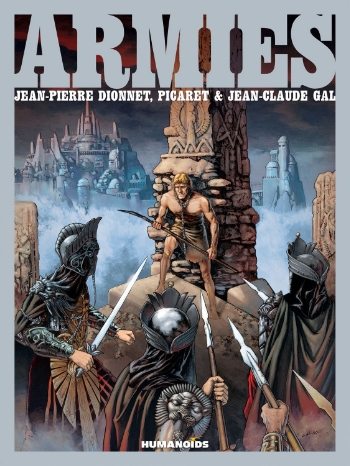
If I can talk a little bit about Conquering Armies itself; if I’m not mistaken, the way you created this comic with Gal was that you would come up with certain images and you would sort of work the story out from the images. Is that correct?
No, that’s not exactly it. The thing is that, I would start with a very clear view of, let’s say, the first four or five pages. He would make some changes, and generally try to un-layer some sequences and to see past un-useful things that I'd have added. Never useful. So, I discovered that he'd made this sort of change, and we talked about it. He didn't tell me yet about his passion for deserts, when we talked about things like that.
So when I saw the first four or five pages, because he was very slow – because he had to work, drawing at school [Gal was an art teacher], and going to the desert each year – I saw that I had to bring in a sequence where he could open more. And sometimes, he had three scenes where characters were up front, like actors. And I'd say, “Oh, this guy, I must start with him, because you like him.” And since we took a lot of time, doing Conquering Armies first - but particularly Arn, we had time, because he was bringing four pages at a time. I would walk with him at his place through next five, and he would cut in front of me and say, “You know, I think this way.” And we always agreed. He'd be doing drawings and drawing on things that we discussed, like Michael Powell's The Thief of Baghdad, etc. But within, it worked.
And so it was a sort of love story, 'til the time I was so buried in work with TV shows and Métal Hurlant, that I gave an outline of the story to Picaret for the second part of Arn, after one-third, I think. But he did a very, very nice job because, again, Jean-Claude would, from this outline, do the drawing, and after, I would come again, just to add the words, because Picaret was less lyrical than I was. Me, I don’t like lyrical stuff, but I do it. That’s life.
Yes, mm-hm.
So, we had a good connection this way, and Picaret entered my head very well, but he had, let’s say, an outline of forty pages. It was not broken into panels, so he broke it with Jean-Claude, and when I saw the results I'd just redo the text.
All right, yeah.
And add a lot of text, because I had discovered they always – in French comics, once people were doing a definitive script, with definitive steps, when you see the thing printed, you have people who are saying things in the image, which are re-said in the captions. And that’s stupid! So me, now, when I work with artists, I make dialogue, descriptions, everything - but when the guy brings the drawings, I change the dialogue.
Most of the time I am not the wordiest writer in the world, because if two pages can work without words, I’m happy. For me, sequential art is not big towers of text everywhere. If the flow of the drawing works, it works. I know that now people like, in Europe, to have a lot of text. But they are not the readers I want. They are better served by TV series. I prefer to take the risk to still do what I think is good, and to be a little proud maybe sometimes. To do that sort thing would be very easy for me, but would not be honest.
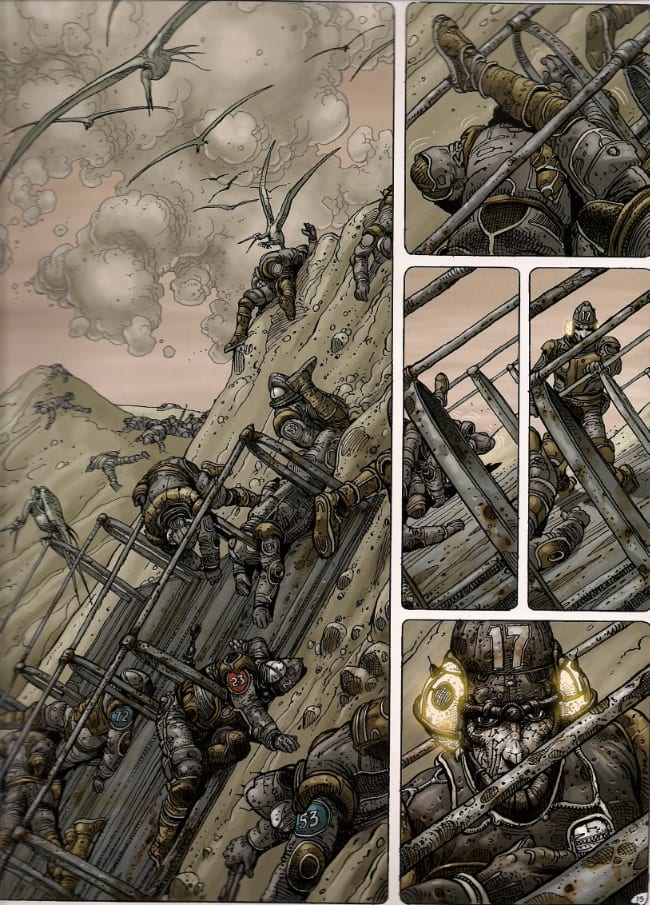
So you would say that this process you go through in creating scenarios for the artist - this would be something you do with, say, Bilal on Exterminator 17 as well as Gal, then.
In Exterminator 17, it was different, because I was at the time - I was doing some sort of layout that he would use or not to see how it worked. Later on, I discovered that it was not a very good thing, because it would touch the flow of the artist. So I stopped doing that, but I was doing lengthy descriptions, and I was, each time, with each artist – it started with Bilal, I think – saying, “That’s my way to tell this page, but if you find a better way that’s ok with me. “
Yes, yes.
And it happened to me lately with a Croatian artist called [Danijel] Žeželj. We made a story that was probably 46, 48 pages long about Nazis. I was born after the war, so I have a sort of - my father was in the army during the war, so I have very strange family stories about both wars, so it was a personal story, but I prefer to read allegorically. Žeželj called me and he said, “Do you care if I add some images in each page that shall not be text images, but just image?” I say, “Of course, I don’t care. I like the way you cut your image.”
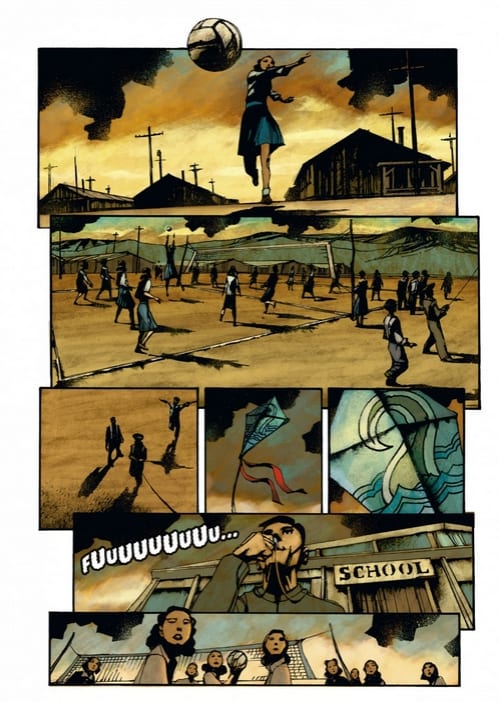
But that was on my last series [2011-12] called Des Dieux et des hommes, Of Gods and Men, which was, to be very frank, a commercial failure. Because I tried - the first one it was Moebius who helped Laurent Theureau, it was very Mobieus-like; he did the cover. The second one was [Roberto] Baldazzini, on the side of his sexy stuff. And I was still relearning to - it’s like a bicycle you know; you always know, but you are no longer in front.
With the third one it was [Peter] Snejbjerg; he made a wonderful funny story. But the fourth one was very depressing. And I think that’s where the series didn’t work. Because it was twelve, seven mercenaries with just two euros, and the next one is a very dark story. And people don’t like that at all. But well, that’s life. So I decided that from now on I shall not try to be with the teenagers, or things like that.
Yeah. Were there only those two albums released in Des Dieux et des hommes, the Theureau -
No, no, no.
Ok.
They shall be releasing in Italy pretty soon, and in Germany pretty soon. Four volumes and an unfinished Theureau story, unpublished, unfortunately.
In the English edition of Armies that Humanoids just put out there’s an afterword by Pat Mills, who is the first editor of the 2000 AD magazine in Britain.
Yes, yes, I was very happy with that.
Yes. He mentions in that essay that he considers the Armies stories to be anti-war and I was just wondering, because you had mentioned earlier that your ideology was “no ideology” as an editor at Métal Hurlant--
No, me, me personally - I was talking about the ideology of the other writers, artists, of the magazine. In my case, I try to not know what I am writing. I was between two worlds. Because I was the son of 1968, of hippie times, but my father was a sort of living legend. He was born in 1900, he started in the war because he was very poor - in the first one, for World War One, he was 14 years old. He became a dragon with a horse and a sword. He became what we call Chasseurs d’Afrique - it means all-black regiment. After, he didn’t talk about what he was doing. Rarely, he was coming back and forth. He was last detail government of Morocco, gave it back to the Moroccans.
He was an adventurer. He never talked about it, but he was doing it. He didn't like fiction stories, and that’s why I wrote the stories, because one day I said, “Oh you must go, that wonderful movie, Lawrence of Arabia.” My father didn't care and moved to the next room, and my mother explained to me, “Oh, your father won a horse competition against your Lawrence. That's the copper cup in the living room: Damas.” We'd never talk about what I was doing, but he let me do it. He said, “You don't want to do the army, don’t do the army.” “Oh, you are the best in the army!” “Oh, you don’t do it. I will not have you sent to the army.” And we never talked, because me and my family, we never talked, but when he died, I opened his safe, and in the safe he had all my books and all the press. But we never talked about it. And so, I think that I was – through Conquering Armies, through Arn, through Exterminator, some of these stories that I did – fascinated by the military. Fascinated by the men trapped in war.
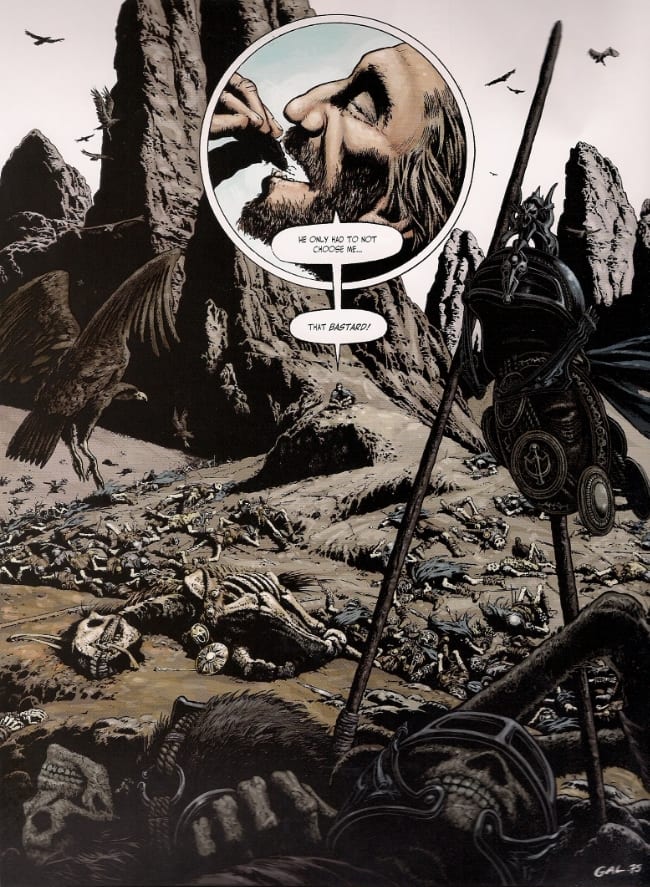
Conquering Armies is what? It’s all conquering armies, but every individual story turns sour. And, it’s a very harsh story because, he [the soldier] wants to win, and by the end he disappears, because he has nothing else to do. So, I think that I love the soldiers who try to do their best in the war. I don’t love the idea of war.
Yes.
But I’m very ambivalent, because my father was military. So what I did was to try, somewhere – a psychologist said to me one day – I tried to understand my father. So it was my own things. And after that – it was exactly like the movie Patton, that was written by [Francis Ford] Coppola. I knew some military guy who said to me, “I like the story. The swords are perfect, the battle looks like a real battle, it doesn’t look fake. You know history. That’s good.” A lot of hippie guys said to me, “Whoa man, it shows the horror of war, it’s terrible.” But I remember Patton, at the time it made the cover of Rolling Stone, like as an anti-war movie, because Patton was crazy – at the same time, it was the favorite movie of Nixon. And I think that a good story must be ambivalent.
And, you know what I’m doing these days? I’m translating, for my own sake, the heroic fantasy poems of General Patton.
Yes. All right.
Because, that’s crazy! This guy is darker than Lovecraft, and what he says is so monstrous, with a lot of music in it. So, Pat Mills took it as anti-war - he was right. But I’ve become like my Japanese friends, who say “what people see, is what they can eat.” And when I married at the military circle with my first wife, with all the artists of Métal Hurlant, there were some generals who came to me, and who said, “We never read comics, but we like your book.” And I think it’s normal, because, funnily enough, most of the soldiers don’t really like war. Because they say, “We don’t decide a war, it’s up there that it is decided.”
And most of them, the ones I met with my father, were very critical on the political side of war. On the way they were sent, to send their men sometimes to death, by people who were in the upper scale. So I’m very ambivalent. That Pat Mills took it as anti-war, I'm very happy with it. He’s more anti-war than me, with Charley's War, whatever. But, he is right. He is right. And with Conquering Armies, I may have been influenced by the [Dino] Buzzati book Il deserto dei Tartari, because I was fascinated by this book where they are waiting for an enemy who shall never come.
And maybe I took something of that, and also - when we started Conquering Armies, more than Arn, which was more violent, I said to Jean-Claude, “We shall take a big war and Genghis Khan, but instead of showing the moments of big war emotion, we shall show the in-between, the holes.” I was fascinated, with Jean-Claude, to show those small things which happen and that shall never be written in scholarly books. But after, when we came to Arn, we decided not to do a fantasy. We decided to make a great history about the world, maybe as it existed in the past, or maybe as it exists in the future. That’s why in the beginning they are extracting in the mountains. I don’t know if it’s past or future.
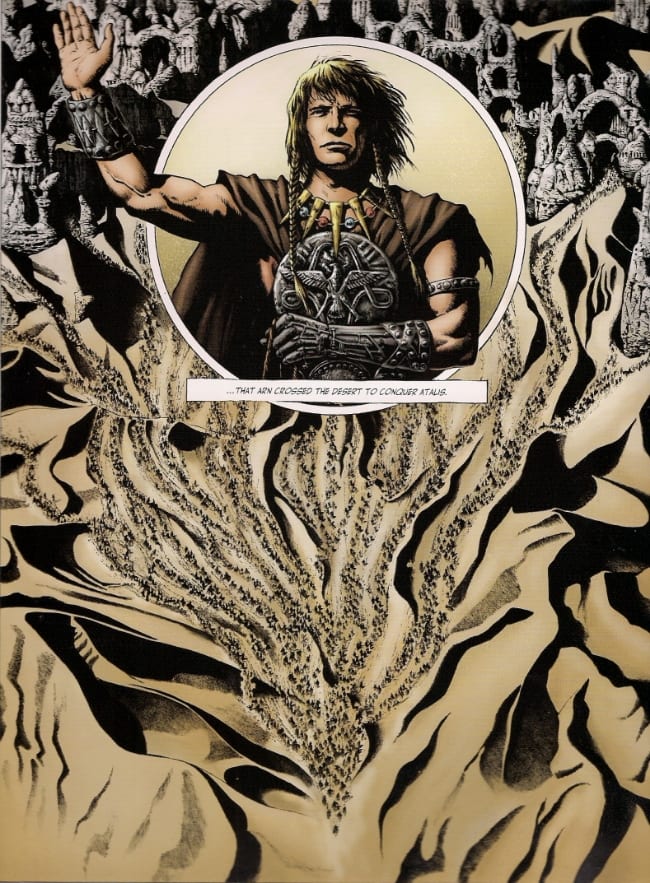
And that story really came in a dream state.
Yes.
Because the story was coming like that - I was very, very proud. It’s the story I am the most proud of in my life, for a very stupid reason. For two reasons. It was a success in Korea, and that I like, because if you can go to Korea, where it’s a different picture, that I like a lot. But the second reason is much more personal. It’s that a few years after we finished Arn, when he was working with [Alejandro] Jodorowsky [on Diosamante], Gal showed me some stories of the Tuareg that were just being translated, and one of those stories was our story. So, it meant that I invented nothing, but I had access, at one time in my life, to a sort of archetype, or a sort of legend in the air, and that I took it.
I have never done it again. Except for Exterminator 17, where I think, before cyberpunk, I am the first one to plug a man into a machine. In a big MacBook.
I am able to say that now because I was very young when I did both. But, after, the fact is that each time I had an idea, I said, “I shall do it later,” and somebody else would do it. And I remember one story I did and, my god, by the time I worked it, one artist had done it. Another time, I did a story that was never published in U.S.A., because there is a lot of sex in it, with mechanized people. And the ending was that they were real animals, coming from the island of Doctor Moreau - and bing! Alan Moore does it. That’s something incredible, because I discover a lot of times, more and more, in the textbooks that are coming, that there is a lot of synchronicity.
Yes, yes.
And the best example, I saw in my own life, is that when Phillipe Druillet was finishing a cover of Pilote with Earth between three hands of steel, like claws, the same month there was an issue of Thor with the same cover. And they could not know! They could not know. So I believe in that. I’m not mystical, but I think that we have access, sometimes, to something that’s bigger than us, that's maybe genetic, that maybe we have all the memories of the world in ourselves. And that we can access it, through elimination, where we are in pretty good shape or very tired.
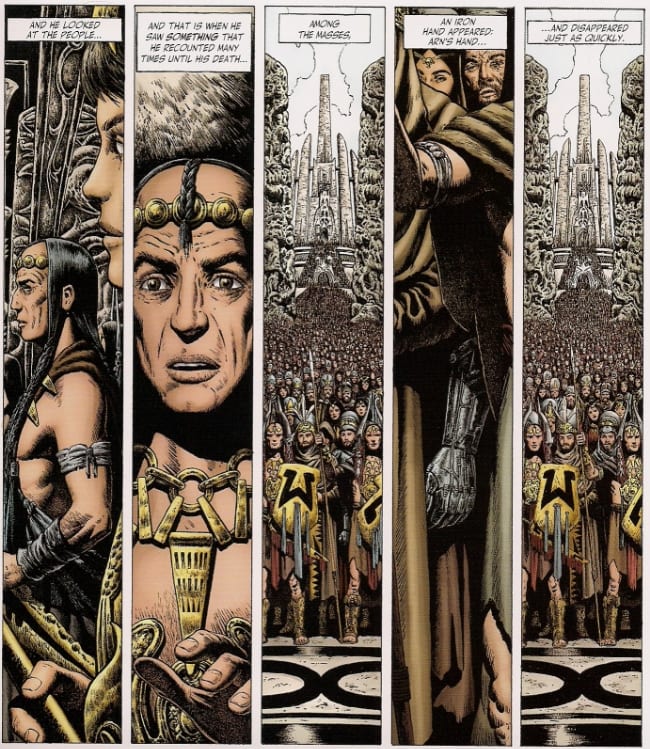
I’d just like to ask you because it’s obvious you read a lot of things, are there any recent comics you’ve enjoyed, just of late?
Oh, yes. One coming from Fantagraphics, because it was Nancy. And I was fascinated by Nancy when I was a kid, because I would never laugh. But I still read it.
Yes, you’re not alone.
But see, even this guy was a prophet one time! Because I have a strip where Nancy can’t spell the word “Afghanistan,” and the dog is outside the school, and she knows to say, “Afghanistan.” And this from 1975, yes, but the date under is September 11.
So I read that. I read lately, because now in France it's coming strong, a lot of comics by [Suehiro] Maruo, the Japanese artist. Totally crazy. I read with a lot of pleasure, but a lot of pain, the last Philémon, by Fred [Aristidès]. Because he just passed. And what else - ah! This guy, that is unknown in America, that I love it a lot called Pierre La Police, his new book. And I read also, in English, the second Captain Easy, and it’s true that somewhere [Roy Crane] is like Kirby, he opens the door, and closes it behind him.
And I read particularly, these days, because I don’t know where it goes - the collaborations through Humanoïdes, Dargaud, Glénat, between Chinese artists and French writers. Because they are creating something that I don’t get totally, but they are interesting. One is called L'Amour à mort, a sort of retelling of Romeo and Juliet. Very strange. There is a thing called Zaya, and there is a crazy book with Humanoïdes called Crusades. And they create a sort of world comic, but maybe it’s good because we have left the world to the big companies.
I said, by the way, to the Dargaud people, that I would like to do a manga someday. And I had an idea about it, because I met the daughter of the artist - there was a manga I liked a lot. It was written by Kazuo Koike: Lady Snowblood [drawn by Kazuo Kamimura]. And I said to the daughter, behaving respectfully, that I would like to write a “Lady Snowblood” someday.
Excellent.
But as usual it was not translated. I don’t know why, but I must have had the idea because I was big fan, and I feel it can be pushed a little later. It shall never work, I know the Japanese. But it would be fun.
Yeah.
I have a project in mainland China of an animation series but it maybe it shall fly, maybe it shall not. And I hope it flies, because I would love to go work in China, I have a lot of friends there. And my French friends these days are depressing me too - we are barking all the time that it’s not the best time of our life. I know. But I have been through all the poor countries, and I know that the Occident is not that poor. You see what I mean? I have been through too much in countries like Tibet or Laos or whatever - Cambodia. Or in Africa. And I know really poor people. I know there is really poor people like in American, like in France some people have no more jobs, that all of us have less money. But we can’t compare. We can’t compare, and I think it’s very egoistical - but I shall never talk about it. I’m a legend guy. I’m a fantasy guy, I never tell the real world. It’s not my thing.
Yeah.
Ah yes, I read a very nice comic book I had never read of Dino Buzzati's by the way.
Oh, all right.
Because he made three, and I had read two and I am reading the third one.
Ok, yeah.
Yeah.
All right. I think that’s everything I need. Thank you for being so generous with your time.
No, you know, because - it’s Moebius who that me that - he said, “Consider when you do an interview, don’t be scared of the interviewer. Consider that as your psychoanalyst. And maybe when you shall read it later, you shall discover things about yourself.”
Yes, yes! Oh, that’s excellent.
And that way, it becomes funny. Because I've already forgot what I said to you. But I know it’s the truth.
--
Or, rather, that was *supposed* to be the end. For many weeks, I thought of synchronicity. Of premonition. The Raymond Poïvet image way up top - it was scanned from my personal collection, which is hardly toppling over from the weight of back issues of Vaillant. In fact, the only issues I've ever found were stuffed inside a battered, torn-up hardcover I got from a comics store for five bucks. I had no compelling reason to make such a purchase, but it looked pretty cool, and it was certainly damn cheap, and so like a protagonist in an old computer game, I put the item into my inventory, figuring it would come in handy later. How could I know those very issues were from precisely the period of Dionnet's childhood, showcasing one of the artists he would specifically identify for me, years later?
And then -- I swear on my honor, my word as my vow -- just as I was typing a capsule entry in a recent column for Humanoids' latest book release, at that very moment: an email arrived from Dionnet, submitting the first piece of what would become a postscript to our talk, which I now submit for the delectation of whatever fates are presently idling.
--
Crumb disinhibited us, Corben was a lesson of other ways to show other worlds, Alex Raymond showed us that to show the infinite we had to connect to our print, and Raymond Poïvet, who learned to paint but had to choose comics, who was very negative on the limits of comics, made us move.
And [Edgar P.] Jacobs wrote me a strange letter: “What you do is the opposite of what I stand for. Go on.”
It's wonderful to be still alive through the past: a very small eternity. Ugly too - so many names of dear friends, now dead. New friends, but who shall never be (Moebius was a little jealous that I had some precious time with Marlon Brando); not so easy it seems, retrospectively. He said to me I wanted to meet Coop, but it is not important they shall never be what I'd call "school friends": 45 years.
I just want to do new things now, to have people in ten years, I hope, saying: "I loved your book of last year..." Fingers crossed.



